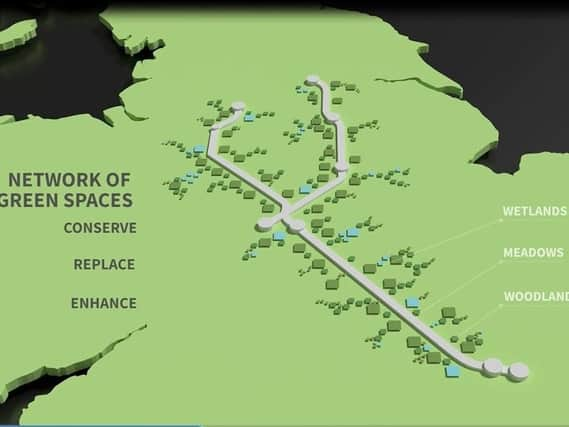Campaigners hit out at HS2 "green corridor"


Green campaigners have hit out at the planned HS2 green corridor, describing it as “smashing a Ming vase and replacing it with bargain basement crockery.”
Along the phase one route from London to the West Midlands, HS2 says seven million new trees and shrubs, covering nine square kilometres, and more than 33 square kilometres of wildlife habit will be created, along with 226 ponds for great crested newts and other animals and bat houses.
Luci Ryan, ecologist at the Woodland Trust said:
Advertisement
Hide AdAdvertisement
Hide Ad“This is utter greenwash nonsense from an organisation trying to pretend that HS2 isn’t the most environmentally destructive infrastructure project this country has seen in decades.
“Some 98 beautiful, rare, irreplaceable ancient woods will be destroyed or damaged by this scheme.
“That’s 98 habitats and ecosystems that support a whole host of mammals, birds, invertebrates, fungi and plants.
“And once that ancient woodland is gone, it’s gone forever so while planting new trees is all well and good, it’s no substitute for what will be lost. Their plans - which let’s not forget are a condition of the scheme, not being delivered out of the goodness of their hearts – fall woefully short of replacing what will be lost on something being touted as a green infrastructure project.
Advertisement
Hide AdAdvertisement
Hide Ad“None of this new planting will replace the 30ha of ancient woodland destroyed on phase 1, and the £2m they are making available on phase 2a as part of the Woodland Fund will not replace the 10.2ha of ancient woodland they are destroying there.
“This is like smashing a Ming vase and replacing it with bargain basement crockery.”
HS2 Limited sent us a list of what will be included in the Bucks Area of HS2, including:
· 31 ponds ranging from 100m2 to 300m2, lined, planted with aquatic plants and the banks grass seeded
· Planting of over 30,000 trees
· Planting of over 1.3km hedgerow
Advertisement
Hide AdAdvertisement
Hide Ad· Installation of fencing, field gates and kissing gates
· Soil preparation and seeding of over 13hectares of grass and wildflower seed
· Installation of 24 bat boxes
· Construction of 4 reptile egg-laying heaps
· Construction of 18 hibernacula and 12 large reptile basking banks
They added: "The aim of the mitigation sites is to create habitat for great crested newts, other amphibians and reptiles, to be moved to once their translocation from areas along the route takes place."
Advertisement
Hide AdAdvertisement
Hide AdThe Berks, Bucks & Oxon Wildlife Trust said: “We welcome the aspiration from HS2 Ltd to create a green corridor along the route of HS2, and we certainly hope that it will create more wildlife habitats, and integrate these with the wider landscape.
“The visual representation of the green corridor in the Green Corridor Vision booklet is far removed from reality. It does not show the gantries and other railway infrastructure including high fences that will impact on the movement of wildlife.
“It is disingenuous to show trees and other vegetation close to the railway line, when we know that tree planting will be done up to 5km from the line to avoid encouraging wildlife close to the railway.
“The negative impacts of HS2 on wildlife will be significant. While we welcome the repetition of the commitment to building green bridges for bats and barn owls among other habitat enhancements in Buckinghamshire, much more needs to be done than is described in the booklet to ensure that the project achieves a net gain for wildlife.”